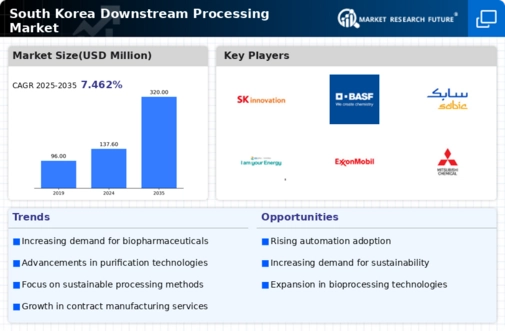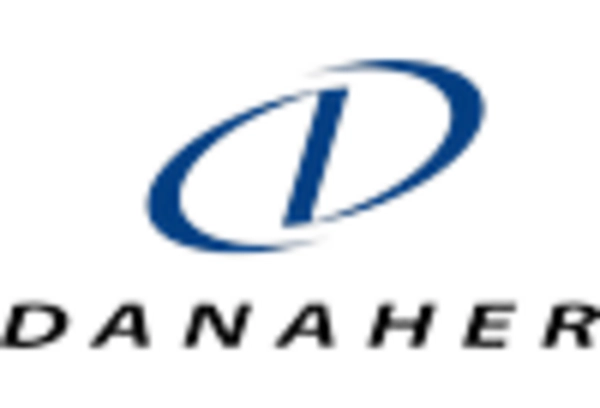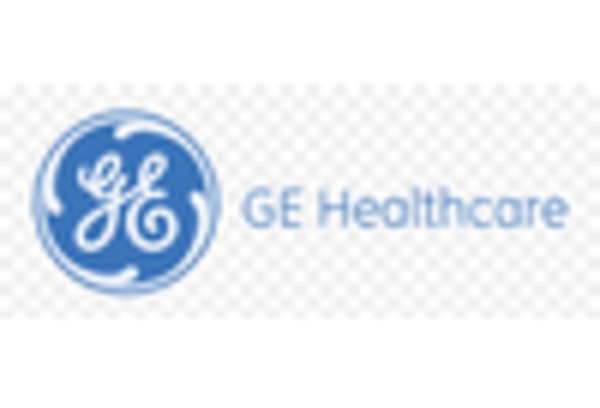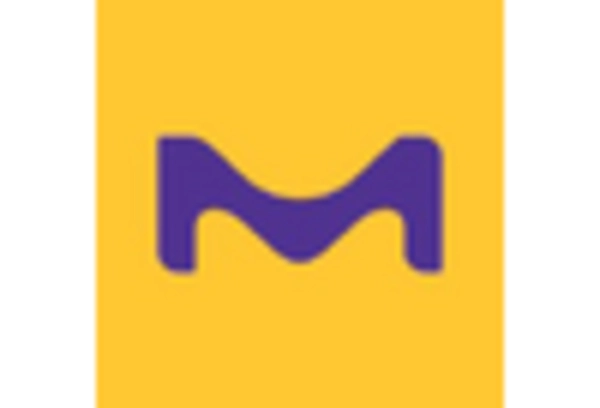Growing Focus on Quality Control
Quality control remains a critical driver for the downstream processing market, particularly in the context of biopharmaceutical production. South Korea's regulatory landscape emphasizes stringent quality standards, necessitating robust downstream processing methodologies. In 2025, it is anticipated that the market for quality control solutions in biopharmaceuticals will grow by approximately 15%. This growth reflects the increasing importance of ensuring product safety and efficacy, which directly impacts the downstream processing market. Companies are likely to invest in advanced analytical techniques and automation to enhance quality assurance processes. As a result, the downstream processing market must evolve to meet these heightened expectations, ensuring compliance with regulatory requirements while maintaining operational efficiency.
Rising Demand for Biopharmaceuticals
The increasing demand for biopharmaceuticals in South Korea is a pivotal driver for the downstream processing market. As the healthcare sector expands, the need for effective drug production processes intensifies. In 2025, the biopharmaceutical market in South Korea is projected to reach approximately $10 billion, indicating a robust growth trajectory. This surge necessitates advanced downstream processing techniques to ensure the efficient purification and formulation of biologics. The downstream processing market must adapt to these demands by enhancing its capabilities, thereby facilitating the production of high-quality therapeutics. Furthermore, the emphasis on personalized medicine is likely to further propel the need for sophisticated downstream processing solutions, as tailored therapies require precise and efficient production methodologies.
Investment in Research and Development
Investment in research and development (R&D) within the biopharmaceutical sector is a significant driver for the downstream processing market. South Korea's government and private entities are increasingly allocating funds to R&D initiatives, with expenditures expected to exceed $5 billion in 2025. This investment fosters innovation in downstream processing technologies, enabling the development of more efficient and cost-effective methods. The downstream processing market stands to benefit from these advancements, as improved technologies can lead to higher yields and reduced processing times. Additionally, collaboration between academic institutions and industry players is likely to enhance the overall capabilities of the downstream processing market, positioning South Korea as a leader in biopharmaceutical manufacturing.
Emergence of Advanced Separation Technologies
The emergence of advanced separation technologies is reshaping the downstream processing market in South Korea. Innovations such as membrane filtration, chromatography, and centrifugation are becoming increasingly prevalent, offering enhanced efficiency and scalability. In 2025, the market for these technologies is projected to grow by 20%, driven by the need for more effective purification processes. The downstream processing market must adapt to these technological advancements to remain competitive. By integrating cutting-edge separation techniques, companies can improve product yields and reduce operational costs. Furthermore, the adoption of these technologies aligns with the broader trend of automation in manufacturing, which is likely to streamline downstream processing operations and enhance overall productivity.
Increasing Regulatory Compliance Requirements
Increasing regulatory compliance requirements are a significant driver for the downstream processing market. South Korea's regulatory authorities are continuously updating guidelines to ensure the safety and efficacy of biopharmaceutical products. In 2025, it is expected that compliance-related expenditures in the biopharmaceutical sector will rise by 10%, reflecting the growing emphasis on regulatory adherence. This trend compels companies within the downstream processing market to invest in compliance management systems and training programs. As regulations become more stringent, the need for reliable and efficient downstream processing solutions becomes paramount. Companies that proactively address these compliance challenges are likely to gain a competitive edge, positioning themselves favorably in the evolving landscape of biopharmaceutical manufacturing.

















Leave a Comment